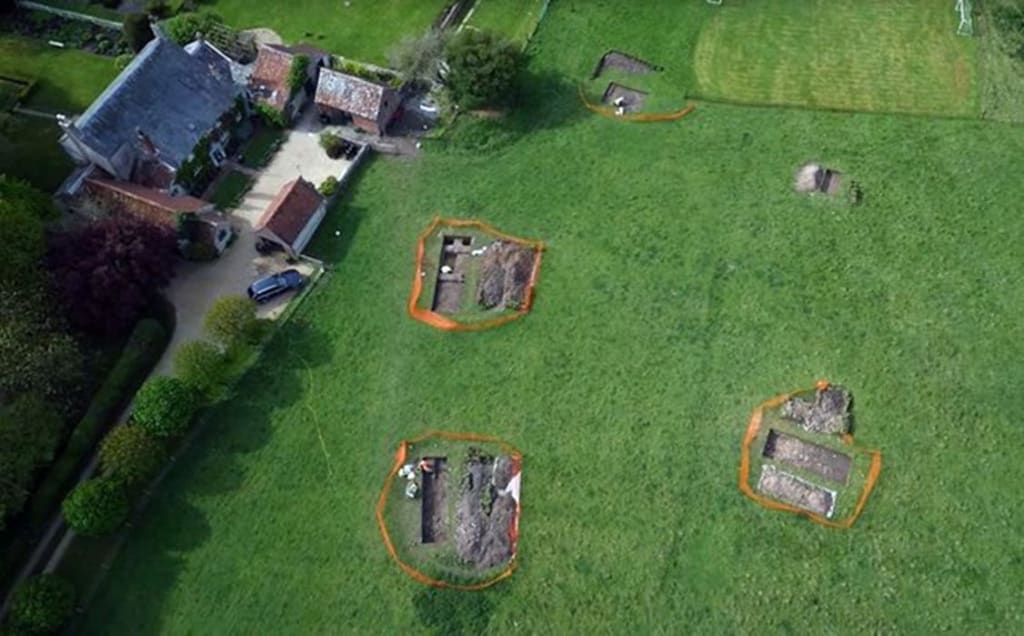THE TALE OF THE DEVERILL ROMAN VILLA
Have you ever fantasised about finding buried treasure? For London-based designer Luke Irwin, that dream came true when he exposed the remnants of a Roman villa in the garden of his home.

Have you ever fantasised about finding buried treasure? For London-based designer Luke Irwin, that dream came true when he exposed the remnants of a Roman villa in the garden of his home.
Luke has now learnt via Historic England, his Wiltshire home is the site of the Deverill Villa, one of the most noteworthy Roman finds in years. In 2016, Luke Irwin and his wife were renovating their barn in England into a room to play table tennis when they exposed a palatial Roman villa under their property.
Soon, Irwin’s property was rapidly filled with archaeologists. The team of archaeologists carried out a ten-day investigative dig, excavating eight trenches on the property. They found that Irwin's farmhouse lay on the site of an imposing Roman villa, thought to be one of the biggest in the country, built between 175 A.D. and 220 A.D., and remodelled until the mid-fourth century A.D.
It was the wish to avoid playing table tennis in the dark that led Luke Irwin to make one of Britain’s most astonishing archaeological discoveries in years. Without that wish, he would not have found out he lived on one of the biggest Roman villas ever built in Britain.
Luke and his wife had decided to transform an old barn on their Wiltshire property. They hired electricians to lay wiring for lights. The electricians initially recommended putting up an overhead cable from the property, but Luke insisted it needed to be an underground cable. It turned out to be a momentous decision.
When the electricians started drilling, they soon hit a solid layer eighteen inches below the surface. They found it full of pieces of mosaic. Fortunately, Luke stopped the workmen before they brandished pickaxes to smash up the mosaic.
He knew the importance of it straight away and called in Historic England, whose archaeologists confirmed the mosaic had been part of the floor of an ostentatious villa built between AD175 and 220.
The house had been created out of two labourers’ cottages and was built in the middle of the old villa. According to the experts, the discovery was of national significance. The detection of such an elaborate, well-preserved villa, untouched by agriculture for over fifteen hundred years, gives a picture-perfect chance to understand Roman and post-Roman Britain.
It is understood the three-storey building, which would have dominated the area, was comparable to the one found at Chedworth, one of Britain’s most significant Roman villa sites. It’s thought to have belonged to a family of high wealth and importance. It is not just the size of the building, which was vast, but the other discoveries that have been made that reveal what a special place this must have been. The team discovered well-preserved mosaics from the second or third century. Further excavating exposed lavish pots, old coins, rare brooches, and many bones. It’s been probable the villa collapsed over 1500 years ago and had stayed untouched ever since. Other artefacts found nearby included coins, a bathhouse, well and pottery. They also found oyster and whelk shells. To keep them fresh, they would have been transported in barrels of saltwater from the sea, which is miles away, showing how wealthy the villa’s owners must have been.
Other discoveries have included the stone coffin of a Roman child. The mosaic has been revealed to be of exceptional quality. Everything about this villa implies it was made of quality materials. Archaeologists identified pieces of stone that have come from at least thirteen different British quarries.
This was the country house of a powerful, wealthy Roman. Undoubtedly, he also had a city house in either London or Cirencester. Interestingly, the house was not devastated after the collapse of the Roman empire. Archaeologists have discovered wooden structures erected in the fifth century. The remains from this period, between the end of Roman occupation and the conclusion of Saxon domination of England, opened a window into one of the least understood ages in British history. It also helped reveal how people responded to the collapse of the Roman empire. Some of the oyster shells that had been found have not been touched by another human for over fifteen hundred years are on show around the Irwin’s house.
About the Creator
Paul Asling
I share a special love for London, both new and old. I began writing fiction at 40, with most of my books and stories set in London.
MY WRITING WILL MAKE YOU LAUGH, CRY, AND HAVE YOU GRIPPED THROUGHOUT.
paulaslingauthor.com






Comments
There are no comments for this story
Be the first to respond and start the conversation.